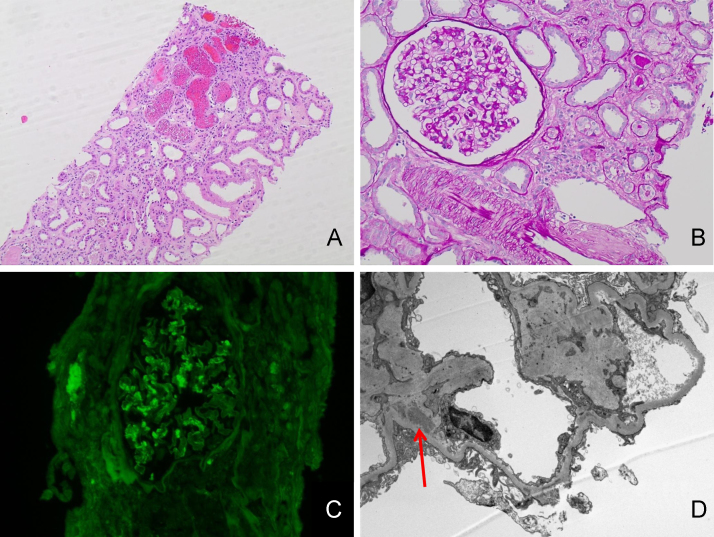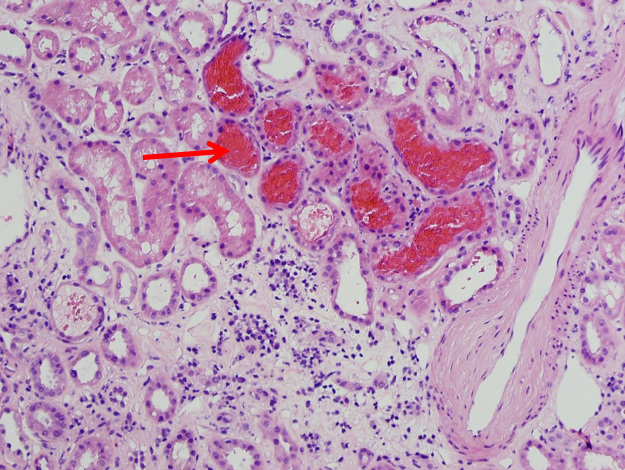1. Nutescu EA, Wittkowsky AK, Burnett A, Merli GJ, Ansell JE, Garcia DA. Delivery of optimized inpatient anticoagulation therapy: consensus statement from the anticoagulation forum.
Ann Pharmacother 47:2013;714ŌĆō724.


2. Brodsky SV, Collins M, Park E, Rovin BH, Satoskar AA, Nadasdy G, Wu H, Bhatt U, Nadasdy T, Hebert LA. Warfarin therapy that results in an International Normalization Ratio above the therapeutic range is associated with accelerated progression of chronic kidney disease.
Nephron Clin Pract 115:2010;c142ŌĆō146.



3. Brodsky SV, Nadasdy T, Rovin BH, Satoskar AA, Nadasdy GM, Wu HM, Bhatt UY, Hebert LA. Warfarin-related nephropathy occurs in patients with and without chronic kidney disease and is associated with an increased mortality rate.
Kidney Int 80:2011;181ŌĆō189.



4. Brodsky SV, Satoskar A, Chen J, Nadasdy G, Eagen JW, Hamirani M, Hebert L, Calomeni E, Nadasdy T. Acute kidney injury during warfarin therapy associated with obstructive tubular red blood cell casts: a report of 9 cases.
Am J Kidney Dis 54:2009;1121ŌĆō1126.


5. An JN, Ahn SY, Yoon CH, Youn TJ, Han MK, Kim S, Chin HJ, Na KY, Chae DW. The occurrence of warfarin-related nephropathy and effects on renal and patient outcomes in korean patients.
PLoS One 8:2013;e57661



6.
7. Ryan M, Ware K, Qamri Z, Satoskar A, Wu H, Nadasdy G, Rovin B, Hebert L, Nadasdy T, Brodsky SV. Warfarin-related nephropathy is the tip of the iceberg: direct thrombin inhibitor dabigatran induces glomerular hemorrhage with acute kidney injury in rats.
Nephrol Dial Transplant 2013 Sep 5 Available at: 10.1093/ndt/gft380. (Epub) 2013 Sep 5.

8. Eknoyan G, Lameire N, Barsoum R, Eckardt KU, Levin A, Levin N, Locatelli F, MacLeod A, Vanholder R, Walker R, Wang H. The burden of kidney disease: improving global outcomes.
Kidney Int 66:2004;1310ŌĆō1314.


9. Zhang QL, Koenig W, Raum E, Stegmaier C, Brenner H, Rothenbacher D. Epidemiology of chronic kidney disease: results from a population of older adults in Germany.
Prev Med 48:2009;122ŌĆō127.


10. Zhang QL, Rothenbacher D. Prevalence of chronic kidney disease in population-based studies: systematic review.
BMC Public Health 8:2008;117



11. Ananthapanyasut W, Napan S, Rudolph EH, Harindhanavudhi T, Ayash H, Guglielmi KE, Lerma EV. Prevalence of atrial fibrillation and its predictors in nondialysis patients with chronic kidney disease.
Clin J Am Soc Nephrol 5:2010;173ŌĆō181.



12. Kooiman J, van de Peppel WR, van der Meer FJ, Huisman MV. Incidence of chronic kidney disease in patients with atrial fibrillation and its relevance for prescribing new oral antithrombotic drugs.
J Thromb Haemost 9:2011;1652ŌĆō1653.


13. Kleinow ME, Garwood CL, Clemente JL, Whittaker P. Effect of chronic kidney disease on warfarin management in a pharmacist-managed anticoagulation clinic.
J Manag Care Pharm 17:2011;523ŌĆō530.


14. Limdi NA, Beasley TM, Baird MF, Goldstein JA, McGwin G, Arnett DK, Acton RT, Allon M. Kidney function influences warfarin responsiveness and hemorrhagic complications.
J Am Soc Nephrol 20:2009;912ŌĆō921.



15. Chan KE, Lazarus JM, Thadhani R, Hakim RM. Warfarin use associates with increased risk for stroke in hemodialysis patients with atrial fibrillation.
J Am Soc Nephrol 20:2009;2223ŌĆō2233.



16. Kapoor KG, Bekaii-Saab T. Warfarin-induced allergic interstitial nephritis and leucocytoclastic vasculitis.
Intern Med J 38:2008;281ŌĆō283.


17. Wysowski DK, Nourjah P, Swartz L. Bleeding complications with warfarin use: a prevalent adverse effect resulting in regulatory action.
Arch Intern Med 167:2007;1414ŌĆō1419.


18. Abt AB, Carroll LE, Mohler JH. Thin basement membrane disease and acute renal failure secondary to gross hematuria and tubular necrosis.
Am J Kidney Dis 35:2000;533ŌĆō536.


19. Kabir A, Nadasdy T, Nadasdy G, Hebert LA. An unusual cause of gross hematuria and transient ARF in an SLE patient with warfarin coagulopathy.
Am J Kidney Dis 43:2004;757ŌĆō760.


20. Spetie DN, Nadasdy T, Nadasdy G, Agarwal G, Mauer M, Agarwal AK, Khabiri H, Nagaraja HN, Nahman NS Jr, Hartman JA, Hebert LA. Proposed pathogenesis of idiopathic loin pain-hematuria syndrome.
Am J Kidney Dis 47:2006;419ŌĆō427.


21. Ozcan A, Ware K, Calomeni E, Nadasdy T, Forbes R, Satoskar AA, Nadasdy G, Rovin BH, Hebert LA, Brodsky SV. 5/6 nephrectomy as a validated rat model mimicking human warfarin-related nephropathy.
Am J Nephrol 35:2012;356ŌĆō364.



22. Ware K, Brodsky P, Satoskar AA, Nadasdy T, Nadasdy G, Wu H, Rovin BH, Bhatt U, Von Visger J, Hebert LA, Brodsky SV. Warfarin-related nephropathy modeled by nephron reduction and excessive anticoagulation.
J Am Soc Nephrol 22:2011;1856ŌĆō1862.



23. Lim AK, Campbell DA. Haematuria and acute kidney injury in elderly patients admitted to hospital with supratherapeutic warfarin anticoagulation.
Int Urol Nephrol 45:2013;561ŌĆō570.


24. Berger R, Salhanick SD, Chase M, Ganetsky M. Hemorrhagic complications in emergency department patients who are receiving dabigatran compared with warfarin.
Ann Emerg Med 61:2013;475ŌĆō479.


25. Nishio S, Tsuboi N, Kurashige M, Tanaka M, Ueda H, Yokoo T, Miyazaki Y, Utsunomiya Y, Hosoya T. A case of acute kidney injury during warfarin therapy.
Nihon Jinzo Gakkai Shi 55:2013;966ŌĆō971.

26. August C, Atzeni A, Koster L, Heidenreich S, Lang D. Acute renal failure in IgA nephropathy: aggravation by gross hematuria due to anticoagulant treatment.
J Nephrol 15:2002;709ŌĆō712.

27. Ware K, Qamri Z, Ozcan A, Satoskar AA, Nadasdy G, Rovin BH, Hebert LA, Nadasdy T, Brodsky SV. N-acetylcysteine ameliorates acute kidney injury but not glomerular hemorrhage in an animal model of warfarin-related nephropathy.
Am J Physiol Renal Physiol 304:2013;F1421ŌĆōF1427.


28. Patel RP, Svistunenko DA, Darley-Usmar VM, Symons MC, Wilson MT. Redox cycling of human methaemoglobin by H
2O
2 yields persistent ferryl iron and protein based radicals.
Free Radic Res 25:1996;117ŌĆō123.


29. Tracz MJ, Alam J, Nath KA. Physiology and pathophysiology of heme: implications for kidney disease.
J Am Soc Nephrol 18:2007;414ŌĆō420.


30. Homsi E, Janino P, de Faria JB. Role of caspases on cell death, inflammation, and cell cycle in glycerol-induced acute renal failure.
Kidney Int 69:2006;1385ŌĆō1392.


31. Tsiftsoglou AS, Tsamadou AI, Papadopoulou LC. Heme as key regulator of major mammalian cellular functions: molecular, cellular, and pharmacological aspects.
Pharmacol Ther 111:2006;327ŌĆō345.


32. Coughlin SR. Protease-activated receptors in hemostasis, thrombosis and vascular biology.
J Thromb Haemost 3:2005;1800ŌĆō1814.


33. Coughlin SR. Protease-activated receptors in vascular biology.
Thromb Haemost 86:2001;298ŌĆō307.


34. Carlile-Klusacek M, Rizzo V. Endothelial cytoskeletal reorganization in response to PAR1 stimulation is mediated by membrane rafts but not caveolae.
Am J Physiol Heart Circ Physiol 293:2007;H366ŌĆōH375.


35. Rondeau E, Vigneau C, Berrou J. Role of thrombin receptors in the kidney: lessons from PAR1 knock-out mice.
Nephrol Dial Transplant 16:2001;1529ŌĆō1531.


36. Xu Y, Zacharias U, Peraldi MN, He CJ, Lu C, Sraer JD, Brass LF, Rondeau E. Constitutive expression and modulation of the functional thrombin receptor in the human kidney.
Am J Pathol 146:1995;101ŌĆō110.


37. Favaloro EJ, Lippi G. Laboratory testing and/or monitoring of the new oral anticoagulants/antithrombotics: for and against?
Clin Chem Lab Med 49:2011;755ŌĆō757.


38. Stangier J. Clinical pharmacokinetics and pharmacodynamics of the oral direct thrombin inhibitor dabigatran etexilate.
Clin Pharmacokinet 47:2008;285ŌĆō295.


39. Wienen W, Stassen JM, Priepke H, Ries UJ, Hauel N. Effects of the direct thrombin inhibitor dabigatran and its orally active prodrug, dabigatran etexilate, on thrombus formation and bleeding time in rats.
Thromb Haemost 98:2007;333ŌĆō338.


40. Wienen W, Stassen JM, Priepke H, Ries UJ, Hauel N. In-vitro profile and ex-vivo anticoagulant activity of the direct thrombin inhibitor dabigatran and its orally active prodrug, dabigatran etexilate.
Thromb Haemost 98:2007;155ŌĆō162.


41. Ware KM, Vance JC, Muni N, Hebert LA, Satoskar AA, Nadasdy G, Ivanov I, Nadasdy T, Rovin BH, Brodsky SV. Oral warfarin and the thrombin inhibitor dabigatran increase blood pressure in rats: hidden danger of anticoagulants?
Am J Hypertens 2014 ,
10.1093/ajh/hpu129, 2014, in press.

42. Liu C, Wan J, Yang Q, Qi B, Peng W, Chen X. Effects of atorvastatin on warfarin-induced aortic medial calcification and systolic blood pressure in rats.
J Huazhong Univ Sci Technolog Med Sci 28:2008;535ŌĆō538.


43. Krishnan S, Chawla N, Ezekowitz MD, Peixoto AJ. Warfarin therapy and systolic hypertension in men with atrial fibrillation.
Am J Hypertens 18:2005;1592ŌĆō1599.


44. Dao HH, Essalihi R, Graillon JF, Lariviere R, De Champlain J, Moreau P. Pharmacological prevention and regression of arterial remodeling in a rat model of isolated systolic hypertension.
J Hypertens 20:2002;1597ŌĆō1606.


45. Essalihi R, Dao HH, Yamaguchi N, Moreau P. A new model of isolated systolic hypertension induced by chronic warfarin and vitamin K1 treatment.
Am J Hypertens 16:2003;103ŌĆō110.


46. Lim MA, Shafique S, See SY, Khan FN, Parikh CR, Peixoto AJ. Effects of warfarin on blood pressure in men with diabetes and hypertensionŌĆöa longitudinal study.
J Clin Hypertens (Greenwich) 9:2007;256ŌĆō258.








 PDF Links
PDF Links PubReader
PubReader Full text via DOI
Full text via DOI Download Citation
Download Citation Print
Print
















